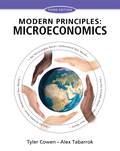
Subpart (a):
Production possibilities frontier of Mexico and United States.
Subpart (a):
Explanation of Solution
The production possibilities frontier of Mexico and United States is shown in Figure 1 below:
Figure 1 shows the
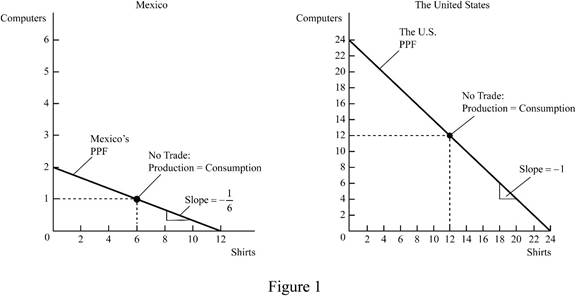
In Figure 1, the left side diagram shows PPF of Mexico and right side diagram shows the PPF of US. The vertical axis of both measures the number of computers produced by Mexico and United States, and the horizontal axis measures the number of shirts. Mexico produces 2 computers and 12 shirts, and United States produces 24 computers and 24 shirts.
Concept introduction:
Production possibilities frontier (PPF): PPF refers to the different combination of goods and services that can be produced efficiently with the given resources by a country. Any points inside the PPF represent inefficient usage of the resources, and any points outside the PPF represent that it is not attainable with the available resources.
Subpart (b):
Calculation of opportunity cost .
Subpart (b):
Explanation of Solution
The equation to calculate the opportunity cost is shown below.
Substitute the respective values in Equation (1) to calculate the opportunity cost of producing a shirt in Mexico.
Opportunity cost of producing a shirt in Mexico is 0.1666.
Substitute the respective values in Equation (1) to calculate the opportunity cost of producing a shirt in United States.
Opportunity cost of producing a shirt in United States is 1.
Mexico has to produce more number of shirts. This is because when comparing the opportunity cost of producing a shirt in both countries, Mexico has the lowest opportunity cost.
Concept introduction:
Opportunity cost: Opportunity cost refers to the value of forgone goods and services to consume the other goods and services.
Sub part (c):
Calculation of opportunity cost.
Sub part (c):
Explanation of Solution
Substitute the respective values in Equation (1) to calculate the opportunity cost of producing a computer in Mexico.
The opportunity cost of producing a computer in Mexico is 6.
Substitute the respective values in Equation (1) to calculate the opportunity cost of producing a computer in United States.
Opportunity cost of producing a computer in United States is 1.
United States has to produce more number of computers. This is because when comparing the opportunity of producing a computer in both countries, United States has the lowest opportunity cost.
Concept introduction:
Opportunity cost: Opportunity cost refers to the value of forgone goods and services to consume the other goods and services.
Sub part (d):
Production possibility frontier.
Sub part (d):
Explanation of Solution
On the basis of opportunity cost of producing a shirt and a computer in both countries, Mexico has a
Figure 2 shows the PPF of trade alliance between United States and Mexico.
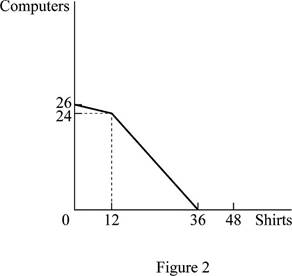
In Figure 2, the vertical axis measures the volume of production of computers and the horizontal axis measures the volume of production of shirts. United States produces 24 units of computer and Mexico produces 1 unit. In the case of shirt, Mexico produces 12 units and United States produces 24 units.
Concept introduction:
Production possibilities frontier (PPF): PPF refers to the different combination of goods and services that can be produced efficiently with the given resources by a country. Any points inside the PPF represent inefficient usage of the resources, and any points outside the PPF represent that it is not attainable with the available resources.
Sub part (e):
Production possibility frontier.
Sub part (e):
Explanation of Solution
The trade alliance after the entrance of Haiti is shown below:
Figure 3 shows the PPF of trade alliance of Haiti, Mexico, and United States.
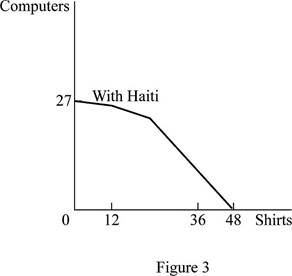
In Figure 3, the vertical axis measures the volume of production of computers and the horizontal axis measures the volume of production of shirts. This is the new PPF after the trade alliance of Haiti with the trade alliance between Mexico and United States. Haiti is producing 1 unit of computer and 12 units of shirt.
Concept introduction:
Production possibilities frontier (PPF): PPF refers to the different combination of goods and services that can be produced efficiently with the given resources by a country. Any points inside the PPF represent inefficient usage of the resources, and any points outside the PPF represent that it is not attainable with the available resources.
Sub part (f):
Production possibility frontier.
Sub part (f):
Explanation of Solution
The PPF of trade alliance of existing three countries and many countries who join the trade alliance is shown below.
Figure 4 shows the PPF for trade alliance between infinity numbers of countries.
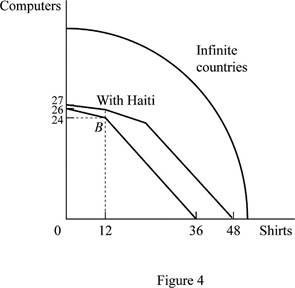
In Figure 4, the vertical axis measures the volume of production of computers and the horizontal axis measures the volume of production of shirts. The first curve represents that PPF is the trade alliance between Mexico and United States. The second curve represents that PPF is the trade alliance between Mexico, United States with Haiti. The third curve represents the PPF of trade alliance between infinity numbers of countries.
Concept introduction:
Production possibilities frontier (PPF): PPF refers to the different combination of goods and services that can be produced efficiently with the given resources by a country. Any points inside the PPF represent inefficient usage of the resources, and any points outside the PPF represent that it is not attainable with the available resources.
Want to see more full solutions like this?
Chapter 2 Solutions
EBK MODERN PRINCIPLES OF MICROECONOMICS
- Evaluate the effectiveness of supply and demand models in predicting labor market outcomes. Justify your assessment with specific examples from real-world labor markets.arrow_forwardExplain the difference between Microeconomics and Macroeconomics? 2.) Explain what fiscal policy is and then explain what Monetary Policy is? 3.) Why is opportunity cost and give one example from your own of opportunity cost. 4.) What are models and what model did we already discuss in class? 5.) What is meant by scarcity of resources?arrow_forward2. What is the payoff from a long futures position where you are obligated to buy at the contract price? What is the payoff from a short futures position where you are obligated to sell at the contract price?? Draw the payoff diagram for each position. Payoff from Futures Contract F=$50.85 S1 Long $100 $95 $90 $85 $80 $75 $70 $65 $60 $55 $50.85 $50 $45 $40 $35 $30 $25 Shortarrow_forward
- 3. Consider a call on the same underlier (Cisco). The strike is $50.85, which is the forward price. The owner of the call has the choice or option to buy at the strike. They get to see the market price S1 before they decide. We assume they are rational. What is the payoff from owning (also known as being long) the call? What is the payoff from selling (also known as being short) the call? Payoff from Call with Strike of k=$50.85 S1 Long $100 $95 $90 $85 $80 $75 $70 $65 $60 $55 $50.85 $50 $45 $40 $35 $30 $25 Shortarrow_forward4. Consider a put on the same underlier (Cisco). The strike is $50.85, which is the forward price. The owner of the call has the choice or option to buy at the strike. They get to see the market price S1 before they decide. We assume they are rational. What is the payoff from owning (also known as being long) the put? What is the payoff from selling (also known as being short) the put? Payoff from Put with Strike of k=$50.85 S1 Long $100 $95 $90 $85 $80 $75 $70 $65 $60 $55 $50.85 $50 $45 $40 $35 $30 $25 Shortarrow_forwardThe following table provides information on two technology companies, IBM and Cisco. Use the data to answer the following questions. Company IBM Cisco Systems Stock Price Dividend (trailing 12 months) $150.00 $50.00 $7.00 Dividend (next 12 months) $7.35 Dividend Growth 5.0% $2.00 $2.15 7.5% 1. You buy a futures contract instead of purchasing Cisco stock at $50. What is the one-year futures price, assuming the risk-free interest rate is 6%? Remember to adjust the futures price for the dividend of $2.15.arrow_forward
- 5. Consider a one-year European-style call option on Cisco stock. The strike is $50.85, which is the forward price. The risk-free interest rate is 6%. Assume the stock price either doubles or halves each period. The price movement corresponds to u = 2 and d = ½ = 1/u. S1 = $100 Call payoff= SO = $50 S1 = $25 Call payoff= What is the call payoff for $1 = $100? What is the call payoff for S1 = $25?arrow_forwardMC The diagram shows a pharmaceutical firm's demand curve and marginal cost curve for a new heart medication for which the firm holds a 20-year patent on its production. Assume this pharmaceutical firm charges a single price for its drug. At its profit-maximizing level of output, it will generate a total profit represented by OA. areas J+K. B. areas F+I+H+G+J+K OC. areas E+F+I+H+G. D. - it is not possible to determine with the informatio OE. the sum of areas A through K. (...) Po P1 Price F P2 E H 0 G B Q MR D ōarrow_forwardPrice Quantity $26 0 The marketing department of $24 20,000 Johnny Rockabilly's record company $22 40,000 has determined that the demand for his $20 60,000 latest CD is given in the table at right. $18 80,000 $16 100,000 $14 120,000 The record company's costs consist of a $240,000 fixed cost of recording the CD, an $8 per CD variable cost of producing and distributing the CD, plus the cost of paying Johnny for his creative talent. The company is considering two plans for paying Johnny. Plan 1: Johnny receives a zero fixed recording fee and a $4 per CD royalty for each CD that is sold. Plan 2: Johnny receives a $400,000 fixed recording fee and zero royalty per CD sold. Under either plan, the record company will choose the price of Johnny's CD so as to maximize its (the record company's) profit. The record company's profit is the revenues minus costs, where the costs include the costs of production, distribution, and the payment made to Johnny. Johnny's payment will be be under plan 2 as…arrow_forward
- Which of the following is the best example of perfect price discrimination? A. Universities give entry scholarships to poorer students. B. Students pay lower prices at the local theatre. ○ C. A hotel charges for its rooms according to the number of days left before the check-in date. ○ D. People who collect the mail coupons get discounts at the local food store. ○ E. An airline offers a discount to students.arrow_forwardConsider the figure at the right. The profit of the single-price monopolist OA. is shown by area D+H+I+F+A. B. is shown by area A+I+F. OC. is shown by area D + H. ○ D. is zero. ○ E. cannot be calculated or shown with just the information given in the graph. (C) Price ($) B C D H FIG шо E MC ATC A MR D = AR Quantityarrow_forwardConsider the figure. A perfectly price-discriminating monopolist will produce ○ A. 162 units and charge a price equal to $69. ○ B. 356 units and charge a price equal to $52 for the last unit sold only. OC. 162 units and charge a price equal to $52. OD. 356 units and charge a price equal to the perfectly competitive price. Dollars per Unit $69 $52 MR 162 356 Output MC Darrow_forward

 Principles of Economics (12th Edition)EconomicsISBN:9780134078779Author:Karl E. Case, Ray C. Fair, Sharon E. OsterPublisher:PEARSON
Principles of Economics (12th Edition)EconomicsISBN:9780134078779Author:Karl E. Case, Ray C. Fair, Sharon E. OsterPublisher:PEARSON Engineering Economy (17th Edition)EconomicsISBN:9780134870069Author:William G. Sullivan, Elin M. Wicks, C. Patrick KoellingPublisher:PEARSON
Engineering Economy (17th Edition)EconomicsISBN:9780134870069Author:William G. Sullivan, Elin M. Wicks, C. Patrick KoellingPublisher:PEARSON Principles of Economics (MindTap Course List)EconomicsISBN:9781305585126Author:N. Gregory MankiwPublisher:Cengage Learning
Principles of Economics (MindTap Course List)EconomicsISBN:9781305585126Author:N. Gregory MankiwPublisher:Cengage Learning Managerial Economics: A Problem Solving ApproachEconomicsISBN:9781337106665Author:Luke M. Froeb, Brian T. McCann, Michael R. Ward, Mike ShorPublisher:Cengage Learning
Managerial Economics: A Problem Solving ApproachEconomicsISBN:9781337106665Author:Luke M. Froeb, Brian T. McCann, Michael R. Ward, Mike ShorPublisher:Cengage Learning Managerial Economics & Business Strategy (Mcgraw-...EconomicsISBN:9781259290619Author:Michael Baye, Jeff PrincePublisher:McGraw-Hill Education
Managerial Economics & Business Strategy (Mcgraw-...EconomicsISBN:9781259290619Author:Michael Baye, Jeff PrincePublisher:McGraw-Hill Education





